 W
WThe Warsaw Uprising was a major World War II operation, in the summer of 1944, by the Polish underground resistance, led by the Polish resistance Home Army, to liberate Warsaw from German occupation. The uprising was timed to coincide with the retreat of the German forces from Poland ahead of the Soviet advance. While approaching the eastern suburbs of the city, the Red Army temporarily halted combat operations, enabling the Germans to regroup and defeat the Polish resistance and to destroy the city in retaliation. The Uprising was fought for 63 days with little outside support. It was the single largest military effort taken by any European resistance movement during World War II.
 W
W104 Company of Syndicalists was a military unit created by the Union of Polish Syndicalists, which participated in the Warsaw Uprising.
 W
WThe failure of the Warsaw Uprising and subsequent Capitulation agreement left Warsaw almost uninhabited. The city was almost totally destroyed with no major monuments left standing. This, however, was not the end. The Home Army was in disarray and unprepared to deal with the Soviet NKVD which subsequently took control of Poland and sent many of the former resistance fighters to their deaths in Siberian gulags.
 W
WThe Warsaw airlift or Warsaw air bridge was a British-led operation to re-supply the besieged Polish resistance Home Army (AK) in the Warsaw Uprising against Nazi Germany during the Second World War, after nearby Soviet forces chose not to come to its aid. It took place between 4 August and 28 September 1944 and was conducted by Polish, British, Canadian, Australian, New Zealand and South African airmen flying from Celone and Brindisi in Italy and denied flyover rights from their Soviet allies, who shot at them when the planes entered Soviet airspace. On 18 September, in the final stages of the Nazis crushing the uprising, one United States airdrop was launched from Great Britain and landed at Poltava in Soviet Ukraine as the distance to the drop-zone precluded the aircraft returning to base. The flights from Italy were night operations with low level cargo drops, conducted without fighter escort while the single United States Army Air Forces mission of 18 September 1944 was a high-altitude, daylight operation consisting of 107 B-17s protected by P-51 fighters. From the night of 13/14 September, Soviet aircraft flew some supply drops, dropping about 130 tons in total until 27/28 September. Initially, this cargo was dropped without parachutes, resulting in much of the payload being damaged or destroyed.
 W
WRoger Barlet was a French soldier.
 W
WBattalion Parasol was a Scouting battalion of the Armia Krajowa, the primary Polish resistance movement in World War II. It consisted primarily of members of the Gray Ranks. The battalion distinguished itself in numerous underground operations and took part in the Warsaw Uprising of 1944, as an element of the Radosław Group.
 W
WBattalion Zośka was a Scouting battalion of the Polish resistance movement organisation - Home Army during World War II. It mainly consisted of members of the Szare Szeregi paramilitary Boy Scouts. It was formed in late August 1943. A part of the Radosław Group, the battalion played a major role in the Warsaw Uprising of 1944.
 W
WBiuletyn Informacyjny was a Polish underground weekly published covertly in General Government territory of occupied Poland during World War II. The magazine was edited by Aleksander Kamiński and distributed as the main organ of ZWZ-AK headquarters in Warsaw, initially in order to inform the AK soldier about ongoing resistance activities. By 1944 Biuletyn Informacyjny had a circulation of 42,000-43,000 copies. The publishers recommended readers to have the articles reprinted in provincial underground publications throughout Poland.
 W
WThe Błyskawica radio station was an insurgent radio transmitter broadcasting from Warsaw during the Warsaw Uprising of 1944, since 8 August 1944 until the end of the struggle. The transmitter was constructed by Antoni Zębik pseudonym "Biegły". Its signal was the melody of Warszawianka.
 W
WThe Warsaw Uprising of 1944 was ended through a capitulation agreement which guaranteed not only the rights of the resistance to be treated as prisoners of war but also was designed to guarantee the fair treatment of the civilians living in Warsaw. This agreement, between General Tadeusz Bór-Komorowski and General Erich von dem Bach, which had taken a long period of on and off negotiations to achieve.
 W
WThe Chrobry II Battalion was a unit, formally subordinate to the Polish Home Army (AK), which took part in the Warsaw Uprising. It was named after the Polish king Bolesław I Chrobry.
 W
WThe Cross of the Warsaw Uprising was an informal award used by soldiers of the Polish resistance during the Warsaw Uprising of 1944. It consisted of a (captured) German Iron Cross, with a pre-war 1 złoty coin pinned to it in the centre over the swastika. The reverse side of the coin, showing the Polish eagle, was displayed, to which was added a kotwica and the inscription "1944", it was awarded for killing an SS officer in combat.
 W
WThe Monuments to the Warsaw Uprising were first established in Warsaw in the 1970s. Prior to that, there were only monuments to the Red Army soldiers and the Armia Ludowa soldiers. The role of the latter in the city fights in 1944 was exaggerated and overrated. Most of the victims of the Uprising who were buried in graves all over the city were later exhumed and buried in mass graves far away from the city centre, with a small concrete monument to "the victims of the war with Nazism". No mention of the Uprising was allowed.
 W
WGęsiówka is the colloquial Polish name for a prison that once existed on Gęsia ("Goose") Street in Warsaw, Poland, and which, under German occupation during World War II, became a Nazi concentration camp.
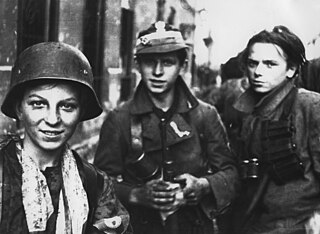 W
W"Gray Ranks" was a codename for the underground paramilitary Polish Scouting Association during World War II.
 W
WGrey Ranks is a role-playing game by Jason Morningstar, independently published by Bully Pulpit Games. The game is designed for three to five players and puts each of them in the shoes of child soldiers during the Warsaw Uprising, serving as members of the Grey Ranks.
 W
WKanał is a 1957 Polish film directed by Andrzej Wajda. It was the first film made about the 1944 Warsaw Uprising, telling the story of a company of Home Army resistance fighters escaping the Nazi onslaught through the city's sewers. Kanał is the second film of Wajda's War Trilogy, preceded by A Generation and followed by Ashes and Diamonds.
 W
WKubuś is a Polish improvised fighting vehicle used by the Home Army in the Warsaw Uprising during World War II. The single vehicle was built in secret to function as an armoured car and armoured personnel carrier for assaults by the Home Army, where it suffered damage and was abandoned after two weeks of service. The original Kubuś vehicle survived the war and is on display in the Polish Army Museum, while a full-scale replica was built for the Warsaw Uprising Museum and frequently takes part in various open-air festivals and reenactment shows.
 W
WThe Warsaw Uprising, in 1944, ended in the capitulation of the city and its near total destruction by the German forces. According to many historians, a major cause of this was the almost complete lack of outside support and the late arrival of the support which did arrive. The only support operation which ran continuously for the duration of the Uprising were night supply drops by long-range planes of the Royal Air Force (RAF), other Commonwealth air forces, and especially units of the Polish Air Force (PAF), which had to use distant airfields in Italy and so had very limited effect.
 W
WThis is a list of military units taking part in the Warsaw Uprising, a Polish insurrection during the Second World War that began on August 1, 1944.
 W
WThis is a list of notable individuals who were involved in the Warsaw Uprising, a Polish insurgence during the Second World War that begun on August 1, 1944.
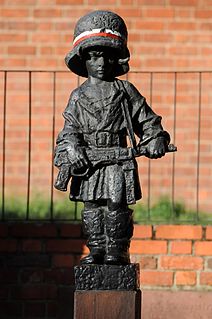 W
WMały Powstaniec is a statue in commemoration of the child soldiers who fought and died during the Warsaw Uprising of 1944. It is located on Podwale Street, Warsaw, Poland, next to the ramparts of Warsaw's Old Town.
 W
WThe Wola Massacre Memorial on Górczewska Street is a war memorial located at 32 Górczewska Street in the Wola district of Warsaw, Poland.
 W
WMichler's Palace or Michla's Palace was a townhouse in Warsaw located at Wolska Street no 40 in the Wola district. It was constructed in the late 19th century and destroyed during the Warsaw Uprising in 1944. It is known for an eponymous wartime song, Pałacyk Michla, which was written by poet and insurgent Józef Szczepański.
 W
WThe Warsaw Uprising began with simultaneous coordinated attacks at 17:00 hours on August 1, 1944 (W-hour). The uprising was intended to last a few days until Soviet forces arrived; however, this never happened, and the Polish forces had to fight almost without any outside assistance. Initially the battle raged throughout most of Warsaw, but after a short time it became confined to districts in the West of the town. The key factor in the battle was the massive imbalance of weapons between the two sides. The German side was extremely well equipped whilst the Polish side had, initially, barely enough ammunition for a few days. The policy of one bullet, one German allowed the Polish fighters to sustain the uprising for many weeks at the cost of their own lives. Some areas fought for a full 63 days before an agreed capitulation took place. The losses on the Polish side amounted to 18,000 soldiers killed, 25,000 wounded and over 250,000 civilians killed; those on the German side amounted to over 17,000 soldiers killed and 9,000 wounded.
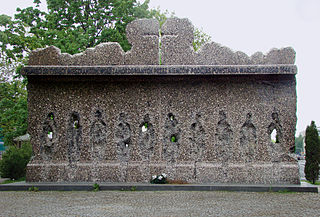 W
WThe Monument to Victims of the Wola Massacre is a monument commemorating the Wola massacre, the brutal mass-murder of the civilian population of Warsaw's Wola district, carried out by the Germans in the early days of the Warsaw Uprising, from 5 to 12 August 1944. It is located in a small square at the intersection of Solidarity Avenue and Leszno Street in Warsaw.
 W
WPAST, also known as PASTa, was a Polish telephone operator in the period between World War I and World War II. It is notable for its main headquarters in Warsaw, which at the time of its construction was the first and tallest skyscraper in the Russian Empire and the tallest building of Warsaw. The fight for the building during the Warsaw Uprising of 1944 also added to the legend of the place.
 W
WPawiak was a prison built in 1835 in Warsaw, Congress Poland.
 W
WThe Battle of Pęcice took place on 2 August 1944 between military units of Armia Krajowa, belonging to the 4th Ochota Sub-district, and the German military during the Warsaw Uprising in Poland during World War II.
 W
WThe Warsaw Uprising occurred at a stage of the Second World War when it was becoming clear that Nazi Germany was likely to lose. The Uprising ended in capitulation, the deaths of over 250,000 civilians, and only 15% of Warsaw intact; with the benefit of hindsight, many people have argued that it should never have been started. Others have argued that it was inevitable and even crucial for Poland to prove its commitment to the Allied cause. Although Stalin was later to describe it as a "criminal enterprise," just two days prior to its initiation, Radio Moscow had called for the Polish people to rise in arms.
 W
WThe Battle of Radzymin was one of a series of engagements between the 1st Byelorussian Front of the Red Army and the XXXIXth Panzer Corps of the German Army. The battle was part of the Lublin-Brest Offensive between 1 and 10 August 1944 at the conclusion of Operation Bagration the Belorussian strategic offensive operation near the town of Radzymin in the vicinity of Warsaw, part of which entailed a large tank battle at Wołomin. It was the largest tank battle on the territories of Poland during the war.
 W
WRising '44: The Battle for Warsaw is the title of a documented and illustrated historical account of the Warsaw Uprising by the historian Norman Davies. It was mostly well received by specialists and commentators during its publication.
 W
WSerbia was a prison for women, located in Warsaw at 26 Dzielnej Street adjacent to the Pawiak prison. It was built by the Russian occupiers of Poland.
 W
WThe Sub-district II of Żoliborz - a territorial organisational unit of the District of Warsaw of Armia Krajowa. It covered the area of Żoliborz in Warsaw, fought in conspiracy during the German occupation of Poland during World War II and openly during the Warsaw Uprising 1944.
 W
WThe Sub-district VII of Warsaw suburbs also called Sub-district collar - a territorial organisational unit of the District of Warsaw of Armia Krajowa, which acted during the German occupation of Poland. Military units of that sub-district took part in the Warsaw Uprising of 1944.
 W
WThe Syndicalist Brigade was a military unit composed of activists from the Union of Polish Syndicalists (ZSP) and the Syndicalist Organization "Freedom" (SWO) and some soldiers of the 104th Company of Syndicalists, which was disbanded on September 6, 1944. The branch took part in the Warsaw Uprising in the Śródmieście district.
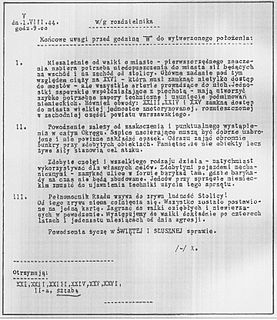 W
W'W' Hour was the codename for the date and time that began Operation Tempest in German-occupied Warsaw, and hence the Warsaw Uprising. The exact time was 5:00 PM, 1 August 1944.
 W
WWarsaw is a turn-based tactical role-playing video game developed and published by Polish studio Pixelated Milk. It was released for PlayStation 4, Microsoft Windows, Nintendo Switch, PlayStation 4 and Xbox One on 2 October 2019, and later for PlayStation 5 on 12 November 2020.
 W
WWarsaw 44 is a 2014 Polish war film, originally titled Miasto 44. The film depicts the Warsaw Uprising in 1944 during the German occupation of Poland.
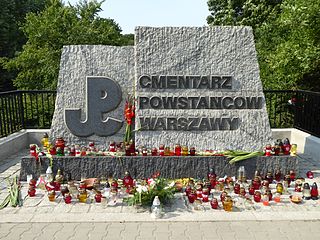 W
WThe Warsaw Insurgents Cemetery is located at 174/176 Wolska Street in the Wola district of Warsaw. It was established in 1945 and occupies 1.5 hectares.
 W
WThe Warsaw Shield,, or Warsaw Arm Shield, was a planned World War II German military decoration intended for award to Wehrmacht and Waffen-SS servicemen who took part in the suppression of the 1944 Warsaw uprising. Although authorised, with the conditions of award and the design approved and announced, production had not begun prior to the end of the war and the award was never issued.
 W
WThe Warsaw Uprising Cross was a Polish military decoration. It was established by law on July 3, 1981 in order to honor the participants of the Warsaw Uprising of 1944. It was discontinued in 1999. It is distinct from Cross of the Warsaw Uprising, which was an informal award instituted during the Uprising itself.
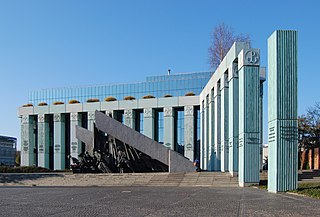 W
WWarsaw Uprising Monument is a monument in Warsaw, Poland, dedicated to the Warsaw Uprising of 1944. Unveiled in 1989, it was sculpted by Wincenty Kućma and the architect was Jacek Budyn. It is located on the southern side of Krasiński Square.
 W
WThe Warsaw Uprising Museum, in the Wola district of Warsaw, Poland, is dedicated to the Warsaw Uprising of 1944. The institution of the museum was established in 1983, but no construction work took place for many years. It opened on July 31, 2004, marking the 60th anniversary of the uprising.
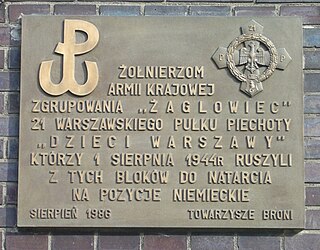 W
WThe Żaglowiec Group - a group of conspiracy military units of Armia Krajowa in the Sub-district II of Żoliborz in Żoliborz of Warsaw during the German occupation of Poland. They fought in the Warsaw Uprising in 1944.
 W
WThe Załuski Library was built in Warsaw in 1747–1795 by Józef Andrzej Załuski and his brother, Andrzej Stanisław Załuski, both Roman Catholic bishops. The library was the first Polish public library, the largest library in Poland, and one of the earliest public libraries in Europe.
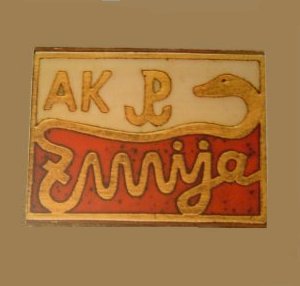 W
WThe Żmija Group - a group of conspiracy military units of the Sub-district II of Żoliborz of Armia Krajowa in Żoliborz in Warsaw during the German occupation of Poland. The units took part in the fights of the Warsaw Uprising of 1944.
 W
WThe Żniwiarz Group was a group of military units in Żoliborz in Warsaw, Poland, which took part in the Warsaw Uprising of 1944.
 W
WThe Żyrafa Group was a group of military units of Armia Krajowa, which fought during the Warsaw Uprising of 1944 in the Sub district II of Żoliborz, which included the Żoliborz district of Warsaw.